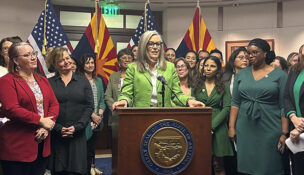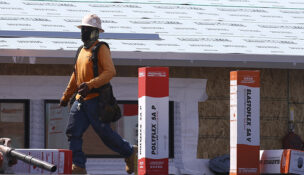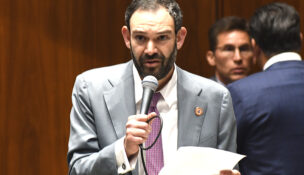Competing trust land measures began with an argument
Arizona Capitol Reports Staff//October 6, 2006//[read_meter]
Competing trust land measures began with an argument
Arizona Capitol Reports Staff//October 6, 2006//[read_meter]
The dirt over competing state trust-land measures began flying in June.
Late that month, the Nature Conservancy led supporters in filing petitions for Prop. 106. “Conserving Arizona’s Future” proposes to amend the Arizona Constitution to conserve nearly 694,000 acres of state trust land. The measure also would establish a board of trustees to administer trust lands.
The Legislature beat them to the punch by a week. In anticipation of Prop. 106, it referred Prop. 105 to the ballot. It also would amend the Constitution to conserve state trust land, but on a smaller scale — some 40,000 acres off the bat. But the Legislature could conserve an additional 400,000 acres. There would be no new governing board. The state land commissioner would continue to oversee the sale and lease of trust lands.
The Arizona Education Association worked with the Nature Conservancy to get 106 on the ballot. The measure also draws support from the Valley Partnership, assorted mayors and Governor Napolitano. The single biggest campaign contributor is the Nature Conservancy, having kicked in more than a half-million dollars to date, according to the Secretary of State’s Office.
Prop. 105 supporters include the Home Builders Association of Central Arizona, the Arizona Cattlemen’s Association, the Arizona Farm Bureau and Arizona School Boards Association. The Home Builders Association has contributed $600,000 to promote 105 and defeat 106 (through “Save Our Trust”).
Both sides claim kinship to the one true proposal for trust-land reform.
Rep. John Nelson, R-12 — a prime sponsor of the resolution that became 105 — harkens back to the summer of 2005. Until then, the opposing parties used to be on the same page, he said. They had been meeting to salvage an earlier effort drafted by an independent commission, but ignored by the Legislature.
He recalled the day of the final meeting, if not exact date.
“We had an agreement on Thursday,” Mr. Nelson said. “When we came back on Friday morning, the other side had walked.”
He all but branded the other side — namely the AEA and the Nature Conservancy — as a rebel faction. Mr. Nelson said he continued to work with remaining parties — including the homebuilders and the cattle ranchers. Those meetings eventually led to Prop. 105.
Pat Graham, state director of the Nature Conservancy in Arizona, has a slightly different recollection of events.
The Nature Conservancy and the AEA sought to stick closely to the original package, the 2004 effort — with a few deletions. For one, they eliminated land exchanges, a proven stinker at the ballot.
Left largely unchanged was the set-aside for conservation, Mr. Graham said. The homebuilders and cattle growers had even helped to identify those lands in earlier talks, he said.
But by summer of last year, the rift had developed, he said.
“They basically told us what we were asking for wouldn’t sail,” Mr. Graham said. “We said, ‘OK, I guess we’ll have to consider other options.’”
They decided to go directly to the voters.
For either proposal, amending the state Constitution would not be enough. Because state trust lands were originally a grant from the federal government, Congress would have to act as well.
These lands are set up to generate revenue. They can be sold or leased only for the “highest and best bid.” Proceeds go into a fund that largely benefits public schools. Buyers include homebuilders and developers. Commercial developers can build shopping centers on trust land through a long-term lease. Trust land also can be leased for grazing or — as of late — conservation.
But conservation is not guaranteed. Prop. 106 would change that, setting aside nearly 700,000 acres immediately. In addition, the newly created board could work with cities, counties or conservation groups like the Nature Conservancy to identify even more trust lands suitable for conservation.
The idea, Mr. Graham said, is to protect “precious lands and waters” from sprawl and pollution.
But 106 supporters also see conservation as a good business model. It will raise more revenue for trust beneficiaries in the long run.
A prime sponsor is the AEA, the state’s largest teachers’ union.
Setting aside land for conservation, “enhances the value of state trust land that does go to market,” said AEA President John Wright. “These are good private-sector principles that will help increase the revenues for public schools.”
In addition, Prop. 106 would let the Land Department partner with private developers. Currently, developers must pay up front for any land — through purchase or lease. But under Prop. 106, they could make improvements before taking title, said Richard Hubbard, president and chief executive officer of Valley Partnership, a nonprofit group that focuses on development. Valley’s board members represent public and private sectors.
The board includes Mark Winkleman, Arizona state land commissioner. Mr. Hubbard stepped down as deputy land commissioner in June to head Valley Partnership. The Land Department’s Web site says the agency takes no stand on Prop. 105 or 106.
As for joint partnership arrangements, they could mean increased revenue for trust lands, Mr. Hubbard said.
“You have a large financially secure company come in and build the infrastructure and split the profits when the property goes to market at a higher level,” he said.
On top of that Prop. 106 requires the Land Department to work with local government in planning for growth. This could mean identifying which trust lands would be suitable for development and which could be set aside for conservation.
Pima County, for one, has made keeping open space a priority with its Sonoran Desert Conservation Plan, said Ann Day, Pima County supervisor.
“To make a community livable, you have to know how to manage growth and manage land,” said Ms. Day, a former state senator.
In Pima County, she added, a lot of that land is part of the trust.
As Prop. 106 would require the Land Department to do more — likely spend more — it also would open up a new source of money. To manage trust lands, the agency could dip into trust-land proceeds. There’s a percentage cap, though the exact formula varies with the size of the permanent fund.
Prop. 106 opponents: Plenty to fume about
These proposed changes have given Prop. 106 opponents plenty to fume about. And Prop. 105 proponents are invariably 106 detractors.
Spencer Kamps, for one, says Prop. 106 is a giveaway to developers. Mr. Kamps, a lobbyist for the Home Builders Association, has temporarily stepped down to head the Save Our Trust committee. He compares the joint-partnership proposal to buying a car.
“It’s like driving it off the lot saying, ‘I’ll pay you in a couple of years.’”
In addition, 106 would allow groups like the Nature Conservancy to acquire trust land — without having to bid on it, Mr. Kamps said.
“106 is the largest special interest giveaway in the history of Arizona,” he said.
Nature Conservancy: Nothing given away
It’s a characterization that Mr. Graham disputes. He says the conservation reserve set up by Prop. 106 falls into three categories. The first is the permanent reserve. Here, about 260,000 acres would be protected from development. These lands, at the discretion of the board of trustees, can be turned over to a local government or a group like the Nature Conservancy — though not if they have existing grazing leases attached to them.
And most of them do, Mr. Graham said.
“Those lands remain in the trust. They continue to earn revenue for the trust,” Mr. Graham said.
Another category includes provisional reserve lands, some 360,000 acres. The board can sell these to local governments, state parks or groups like the Nature Conservancy — but only at full-market value, Mr. Graham said.
“Nothing is given away,” he said.
A third category, he added, includes 75,000 or so acres for an educational reserve. These would be deeded to the Arizona Board of Regents for university research.
In any case, nothing could happen to trust land without the approval of the newly created board, Mr. Graham says.
As it happens, this is cold comfort to the opponents of 106.
Rep. Nelson, for one, believes too much power would be handed over to an unqualified board.
“I can pick a second-grade teacher and put him on the board, or a janitor, making decisions on millions and millions of dollars,” Mr. Nelson said.
Mr. Wright of the AEA, however, dismisses the notion of janitors managing state trust-lands.
“I take this much more seriously than to joke about a thing like that,” he said.
As for qualifications, Mr. Graham said the measure would require board members to have “substantial experience” in dealing with matters before them. But because Prop. 106 is a constitutional measure, he added, the qualifications are not spelled out in detail.
“A lot of the specifics could be more appropriately addressed through statute,” he said.
Another Prop. 106 criticism comes from Bas Aja, director of public affairs for the Arizona Cattlemen’s Association, which opposes Prop. 106. He said funding for trust-land management would come at the expense of the beneficiaries.
Prop. 106, he said, “allows for the bureaucrats at the Land Department to take a portion of the annual proceeds, which would normally go into the permanent fund.”
While nearly 90 percent of state trust lands are tied to public schools, Mr. Kamps says other beneficiaries could be hurt as well. They include the state universities, the Arizona Pioneers Home and the Arizona Schools for the Deaf and Blind, among others.
Prop. 106 advocates, however, say it makes sense to invest trust-land proceeds into trust-land planning. With added revenue, they say, the Land Department could act more quickly to identify and bring to market land suitable for development.
In addition, Mr. Graham said, the Land Department can only get the money if Legislature appropriates it. The only difference, he added, is that it doesn’t come out of the General Fund.
Mr. Kamps, however, said the Legislature has not skimped on the Land Department.
“The Land Department in the last two years received $7 million in increased funding, probably more than any state agency,” he said.
Perhaps the biggest fault with Prop. 106, opponents say, is that it gives the Land Department a philosophical makeover.
“They changed the mission of the trust from one of making money from its assets, to conservation,” Mr. Nelson said. “I don’t have a problem with conservation, but conservation should be done in conjunction with — and follow — the original goals of the trust.”
Ms. Day, however, said it’s time for change. The Land Department has been operating by the same rules since statehood.
“Obviously, this changes the definition, so that sometimes the ‘highest and best bid’ is being set aside for conservation, and I’m for that,” she said.
Mr. Hubbard of Valley Partnership added — that under Prop. 106 — the Land Department would still be obligated to the beneficiaries of the trust.
Prop. 105
As the anti-106, Prop. 105 presents a less ambitious proposal for trust-land conservation. It identifies some 40,000 acres, largely lands earmarked for conservation under the 1996 Arizona Preserves Initiative. Under that initiative, cities could buy nearby state trust lands at full-market value — with a matching grant from the state — and keep them as open space. Legal challenges, however, largely prevented them from doing so.
Prop. 105 removes the legal barrier. Cities must still pay full-market value.
These are trust lands in populated areas faced with ongoing threat of development, Mr. Kamps said. Prop. 106 supporters have wrongly focused on rural areas that no one wants to build on, he said.
“They should have focused their resources on the urban lands,” Mr. Kamps said.
But Prop. 106 supporters said their measure would do more to prevent leapfrog development and sprawl. Mr. Hubbard said some 200,000 acres of urban state trust land have been all but ignored.
“Growth has jumped over that land, and it remains unplanned and undeveloped,” Mr. Hubbard said.
Another Prop. 105 difference lies in the definition of conservation itself. Prop. 105 defines conservation as: “restricting the use of land against development.” For Mr. Aja of the Cattlemen’s Association, the Prop. 106 definition is too broad when it seeks to preserve “natural, cultural or historical assets of land…”
“Preservation and conservation are two different things,” Mr. Aja says.
To him, conservation means something more specific, like range management.
But Mr. Graham of the Nature Conservancy defended preservation of lands for cultural and other reasons.
“Those are all values that exist on state trust lands.” He said, for example, “There are areas that are extremely important to the Hopi and Navajo Indians.”
Other conservation priorities include protecting waterways and wildlife habitat, he said.
Both measures ban building on conservation land
Both measures appear to agree on one thing. They would prohibit new buildings on land set aside for conservation, with some exceptions. But they differ in the details, including timing. Prop. 106 would prohibit development immediately. Prop. 105 would prohibit new development after Jan. 1, 2009.
In addition to urban lands, Prop. 105 provides for 400,000 acres of rural trust land to be set aside for conservation, though it doesn’t map them out. That would be left up to the Legislature.
“I think public hearings on which land ought to be set aside is a good thing,” Mr. Kamps said.
Any land identified for conservation would have to be sold at full-market value. But under Prop. 105, the Legislature cannot attach an emergency clause to any bill conserving trust land, leaving the action open to a challenge by the voters.
In addition, 105 has a built-in self-destruct mechanism. If both measures pass, with Prop. 106 getting the most votes, most of Prop. 105 would be automatically repealed.
“The 400,000 acres evaporates,” says Mr. Nelson. “We didn’t want to put a millions acres on the table. We didn’t want the public thinking that if they went through, they would have to deal with a million acres.”
Web sites
For more pros and cons, Prop. 105 and 106 supporters offer competing Web sites. There’s www.saveourtrust.org (anti-106) and www.conservingarizonasfuture.org (pro-106)
Crowded Ballot
There are 19 propositions on the November ballot. For a complete list see Page 11. This week we feature stories about:
Prop. 105 — State Trust Land (Referred by Legislature)
Amend the state Constitution to change provisions governing the sale or lease of state trust land. Currently trust land may not be sold for less than “true value” and only to the “highest and best bidder.” New provisions would require the Legislature to establish procedures for setting aside up to 400,000 acres in non-urban areas for conservation purposes, and to devise guidelines to ensure the sale of trust land in urban areas be done in consultation with local government. If Prop. 105 and Prop. 106 both pass, provisions of this proposition that conflict with those of Prop. 106 will not be enacted. Full implementation of Prop 105 requires Congressional approval of the changes to the act that authorized Arizona to become a state. Referred by Legislature (HCR 2045, 2006 Reg. Session.)
Prop. 106 — State Trust Land (Proposed by initiative)
Amend the state Constitution to change provisions governing the sale or lease of state trust land. Currently trust land may not be sold for less than “true value” and only to the “highest and best bidder.” A seven-member board of trustees (appointed by the Governor with consent of the Senate) is created to plan and dispose of trust land. The trustees are authorized to adopt guidelines defining when the highest and best bid does not necessarily mean the most money to the state. Approximately 694,000 acres would be set aside for conservation. A portion of sale and lease proceeds may be dedicated to managing trust land and paying costs associated with the Bd of Trustees. Commercial sale/development of trust land must be done in consultation with local government. Full implementation of Proposition 106 requires Congressional approval of the changes to the act that authorized Arizona to become a state. Proposed by initiative petition circulated by Conserving Arizona’s Future


















